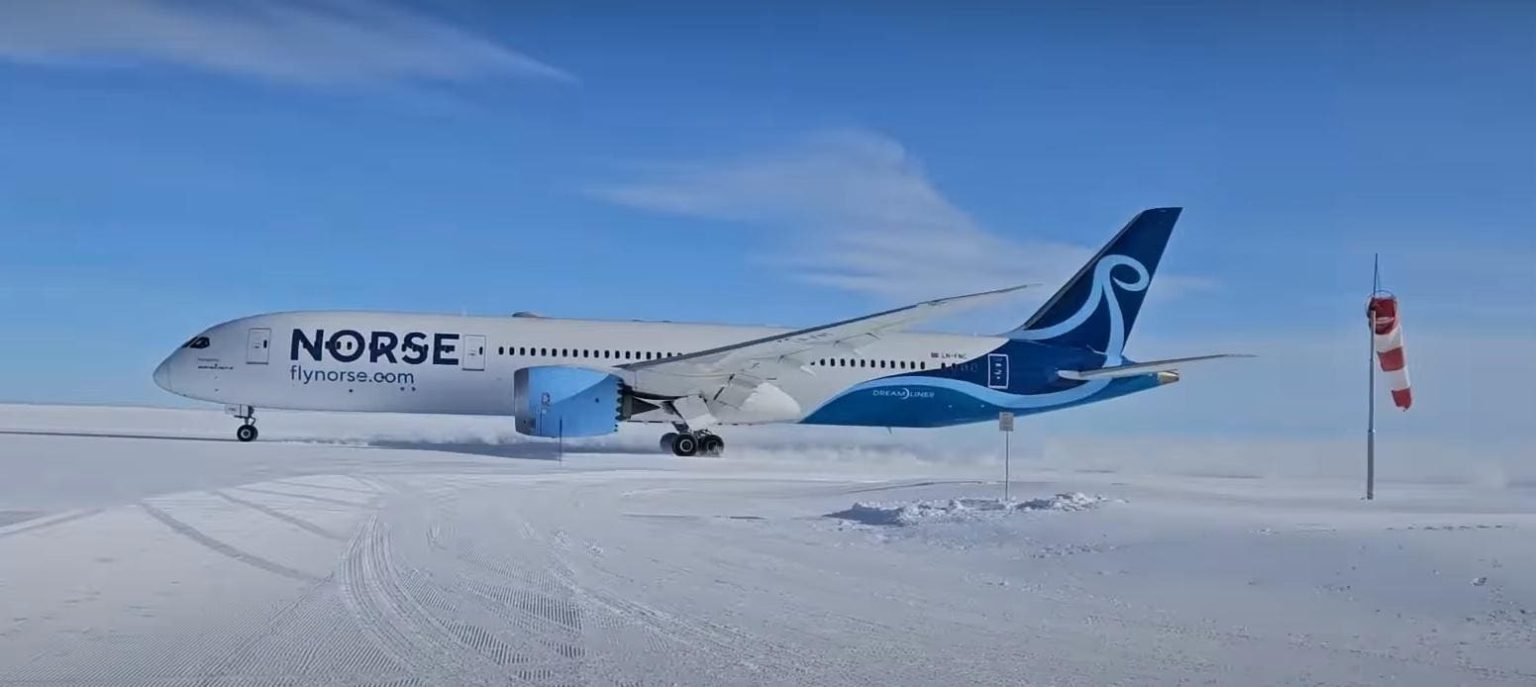When a planeload of scientists landed on the ice at Troll Airfield last week, they arrived in what the media claimed is the largest airplane ever to land in Antarctica.
The Boeing 787 Dreamliner, operated by Scandanavian low-cost carrier, Norse Atlantic Airways, made a round-trip flight from Cape Town, South Africa to Antarctica without refueling. Aboard were 45 passengers, including scientists from the Norwegian Polar Institute and other international research groups, destined for different research stations in Antarctica.
The airplane may be the first 787 to set its main gear on Antarctic ice but the claim that it is the largest to do so doesn’t hold water.
The flight was commissioned by the Norwegian Polar Institute which provides scientific knowledge and advice to Norwegian authorities about the Arctic and the Antarctic.
An environmental monitoring organization, the Institute traces its lineage back to 1928, through vagaries of National Socialism in pre-war Norway, and to the research thrust that shaped its activity in the great-power competition in the Arctic and Antarctic that followed WWII and continues to this day.
The flight, which also carried 12 tons of research equipment headed to the Institute’s remote Troll research station in Queen Maud Land, was executed by a Norse Atlantic Airways aircrew. According to a company release, the Dreamliner left Oslo on November 13th and made a layover stop in Cape Town, South Africa, before departing to the south on its Antarctic leg.
Antarctic flights are relatively routine these days. While there are no scheduled airline services, a constant stream of aircraft bring researchers, military personnel and equipment to Antarctica’s various regions. These include Queen Maud Land, a one million-square-mile region in the north-central portion of the continent claimed by Norway as a dependent territory.
The territory (also called Dronning Maud) hosts 11 nations which pool their airlift resources in order to save costs and operate in a coordinated manner. The 10,830-feet by 330-feet runway blue ice runway where the 787 landed and took off has been called one of the closest things Antarctica has to an air hub.
As such, it has seen some big airplanes. In 2021, widebody aircraft wet lease operator, Hifly, landed an Airbus A340-300 on an ice runway at ‘Wolf’s Fang” an upscale adventure camp for tourists west of Queen Maud Land. Though similar in size, the A340-300 is greater in length with a wider wingspan than the 787-9 which Norse operated.
Other large aircraft are operated in Antarctica by global military forces including the U.S. Air Force which flies Boeing C-17 Globemaster airlifters to the Phoenix Runway near McMurdo Station on Ross Island in the New Zealand-claimed Ross Dependency on the shore of McMurdo Sound in south-central Antarctica.
Though a bit shorter than the 787 and A340, the Globemaster’s maximum takeoff weight is greater than the Dreamliner’s and on par with the A340’s. Other large airplanes that have crunched across Antarctic ice runways include the Ilyushin Il-76, Lockheed Martin C-130 Hercules, Lockheed P-3 Orion, Boeing 757/767 and Airbus A319.
To its credit, Norse Atlantic Airways (which operates 15 787s on European, U.S. and Asian routes) did not claim to have landed the largest airplane in Antarctica. Setting a 787 down on the runway at Troll is nonetheless impressive.
Pilots of other large aircraft have noted that Antarctica’s blue ice runways need preparation in the form of grooving and carving to be safe. Local weather can change in an instant and altimeters suffer from temperature errors in the cold temperatures and require recalibration. Braking action on ice is obviously limited so large jet or turboprop aircraft are slowed with reverse-thrust which is more than adequate for the long runways in operation.
Landing distances are also a function of the aircraft’s gross weight which is high given their fuel loads. There are rarely refueling options for commercial aircraft flying to Antarctica, meaning they have to carry enough fuel to make the roughly 5,000 nautical-mile over-water roundtrip flight from Cape Town.
The capacity of the blue ice runways in Antartica to handle larger aircraft is unclear but given their length 747 or even A380 sized airliners could presumably be accommodated. For now, Norse Atlantic Airways’ 787-9 Dreamliner is the newest member of the Antarctic club – if not quite the largest.
Read the full article here





